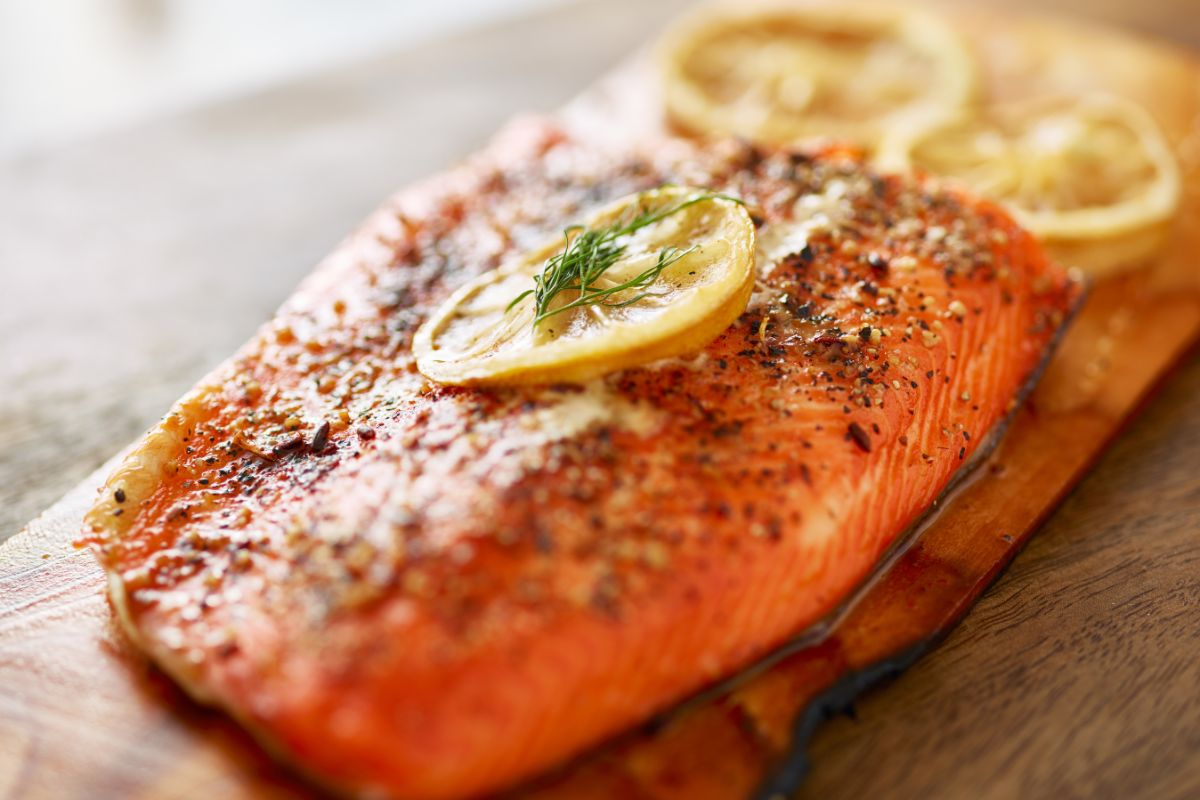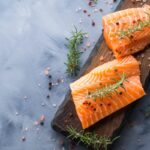Salmon is one of the very best types of fish out there, with its fantastic taste and its brilliantly flaky texture.
However, like with all meats and seafoods, it’s always essential that you cook it properly and that it has been fully cooked before you enjoy it. So, what does cooked salmon look like?

To give you the short answer, the outside of the salmon will be a mix between opaque white and slight pink, while its center should be a semi-translucent pinkish white.
However, there is so much more to learn about this important cooking process!
In our useful guide below, we’ve got a complete and in-depth look at what cooked salmon looks like.
We’ve got a selection of ways to check that your salmon has been properly cooked, advice on how long it typically takes to cook the fish, the key signs of overcooked salmon (which tastes awful!), and much more.
Read on!
How Long Does It Take To Cook Salmon?
Before we get into the different ways that you can check if your salmon has been cooked properly, it’s important to explain how long you should be cooking the fish for in the first place.
After all, if you don’t have an idea of the correct cooking times, then you can’t hope to have a properly cooked salmon at the end!
The cooking times for salmon can vary, based on the cooking method that you’re using and the size of the salmon fillet itself. Naturally, the thicker your fillet is, then the longer it will take to cook.
A rough idea of cooking times is:
- If you’re broiling a thin fillet of salmon, then it could take 4-5 minutes. On the other hand, if the fillet is thicker at about 1 inch thickness, then it could take 7-10 minutes.
- If you grill your salmon on a medium to high level of heat, then it could take 7-8 minutes. This is if the heat is around 375-450 degrees Fahrenheit (190-232 degrees celsius).
- If you’re pan-searing the salmon on a medium to high level of heat, then it can take 4–8 minutes, with you cooking each side of the fish for 2-5 minutes.
- Meanwhile, baking your salmon at around 375 degrees Fahrenheit (190 degrees celsius) can take 13-16 minutes.
None of these timings are going to be the solid truth, but they are good guidelines. Pan-searing salmon is the quickest way to cook your salmon, while baking it takes the longest amount of time.
With that being said, baking is the best for keeping the fish’s moisture.
How Can You Tell Your Salmon Is Fully Cooked?
Of course, since the above information is all rough guidelines for cooking time, you’ll need to check that your final fish has been properly cooked.
It’s dangerous for your health to eat raw or undercooked fish, so you must always ensure that your salmon has been properly cooked.
Thankfully, there are a variety of different methods you can use to check that this is the case. The more of these methods you use, the more thorough your investigation should be!
Check It With A Butter Knife
One method to check that your salmon has been properly cooked is by using a butter knife in a few different ways.
You might wonder why we recommend a butter knife specifically, and it’s because the use of something like a fork (with its many prongs) could ruin your fish.
To start with, gently press the butter knife’s tip into your salmon’s thickest part. If the knife easily goes into the fish, then it’s likely been properly cooked.
Meanwhile, if the knife doesn’t easily go in, then it needs more cooking time.
To test it further, insert the butter knife into the thickest part of the salmon again, then hold it there for 5 seconds. After that, remove the knife and press it carefully to your finger. Is the knife warm?
If the knife still has heat on it, then the salmon has likely finished cooking. On the other hand, a cold knife means that you need to cook the fish for longer.
Finally, use your butter knife to carefully open up some of the fish so that you can check what its insides look like.
If the inside is a semi-translucent pink shade, and the outside is an opaque shade of pink and white, then the fish is likely done.
On top of that, the salmon should be flakey when you’re opening it up, splitting up into flakes. However, we’re going to expand on that in a later section!

Check Internal Temperature With A Thermometer
Another method you should use to check that your salmon has been cooked properly and thoroughly is taking its internal temperature with a food thermometer.
Buy a meat and fish food thermometer, then insert it into the widest part of the salmon, since that will be the part that has taken the longest to get cooked.
What are you looking for with the temperature? Well, if your food thermometer says anything below 110 degrees Fahrenheit (43 degrees celsius), then the fish is basically raw.
The FDA has stated that your salmon should be cooked to 145 degrees Fahrenheit (63 degrees celsius) at least to keep your health safe, so try to aim for more.
If your salmon is measuring 110-125 degrees Fahrenheit (about 43-52 degrees celsius), then it’s moderately cooked and is likely medium rare.
Meanwhile, if the temperature reads 125-140 degrees Fahrenheit (around 43-60 degrees celsius), then the fish should be medium rare to well done, and safe to eat.
However, you can actually overcook the salmon, which ruins the fish and makes it taste horrible.
There are ways to distinguish if your salmon has been overcooked, which we’ll cover soon, but if your food thermometer reads anything above 150 degrees Fahrenheit (65 degrees celsius), then you’ve likely got an overcooked salmon on your hands.
Check The Texture Of The Salmon
Another great way to see if your salmon has been cooked properly is by inspecting its texture, which involves cutting into the fish a bit.
Get a fork and place it into the salmon. If the fish resists your fork and seems rubbery, then it’s raw or undercooked and needs to be cooked for longer.
On the other hand, if the salmon goes all flakey and comes away in fine flakes of fish, then it’s likely cooked properly.
Make sure to check that it’s flakey all over, especially in the broadest part of the fish, since that will have taken the longest to thoroughly cook.
An undercooked piece of salmon might also have a slimy texture to it, which is a big giveaway that you need to cook it for longer.
Check The Color Of The Salmon
Finally, another method you should use involves inspecting the color of the fish. First, look to see if the outside of the fish has an opaque pinkish-white look to it.
Meanwhile, cut inside the salmon and have a look at its center. If the salmon is sheer pink on its inside center, then it’s likely cooked. However, if the center is dark pink in the center, then it’s undercooked and needs to cook more.
What Shouldn’t You Do When Cooking Salmon?
Of course, if you want to increase the chances of your success with properly and thoroughly cooking your salmon, there are a few measures you can take.
You Buy Your Salmon Too Thick
As we mentioned earlier, the thicker a salmon fillet is, the longer it will take to cook properly. However, a thick salmon fillet is also likely to cook unevenly, which is not desirable at all.
As a result, it’s a good idea to focus on the thickness of your salmon fillet when you’re buying it.
When shopping for a salmon fillet, try to get one that is less than an inch in its width. These thinner fillets have a greater chance of cooking evenly and thoroughly.
On the other hand, a salmon fillet whose widest part is wider than 1 inch is likely to cook unevenly – and undercook.
With that being said, thin salmon fillets are more likely to overcook, so be sure to keep a keen eye on their cooking.
You Removed The Salmon Skin
When you’re going to cook a piece of salmon, you might think that you should remove the skin. After all, you rarely eat the skin with meats that you cook, so shouldn’t it come off first?
The answer is no! It’s essential that you leave your salmon’s skin on.
The salmon skin is the silvery section on the underside of your salmon.
It certainly doesn’t look appetizing, but it’s a very good idea to leave it on the fish when cooking, because it helps ensure that the fish doesn’t cook too quickly.
If the salmon cooks too quickly, it takes on an unpleasant texture.
It’s also a good idea not to flip your salmon so that the silver skin is on top, because this can also cause problems with the cooking and affect its texture.

You’re New To Cooking Salmon
It seems obvious, but those who are new to cooking salmon are going to have a harder time getting it cooked properly compared to people who have cooked plenty of salmon in their time.
Salmon isn’t the easiest food to get right on the first go, as you’ll have seen from all the information we’ve covered.
With different cooking times, different cooking methods, different sizes of fillet, and more all at play, it’s unlikely you’ll nail it on the first go. However, you need to keep trying!
Like everything, practice will make perfect, and after a few goes you’re far more likely to be cooking your salmon properly.
You Seasoned The Salmon Too Early
Seasoning your meat and seafood is always a good idea, because it adds extra flavor to the food. However, your salmon can end up rubbery and unpleasant if you apply its seasonings too early.
Since seasonings will take moisture away from the fish when it’s cooking, if you apply to seasonings too early then they could end up depriving the fish of necessary moisture and causing it to end up dry and rubbery.
If you’re cooking your salmon in a pan, then wait for the pan to be fully heated to the right temperature, before adding salt into it straight away and following it with the salmon.
It’s best to season your fish 15 minutes or fewer before you cook it.
Have You Overcooked Your Salmon?
While you definitely don’t want to undercook your salmon, due to health risks like food poisoning, you also don’t want to overcook the fish.
The reason for this is not as much to do with health risks, though, and mainly more for the taste.
With that being said, though, there is a risk that if the fish’s internal temperature gets too high then it could grow harmful bacteria that pose a risk to your health.
As for its taste, overcooked salmon will have a firmness and dryness to it that makes it a lot less pleasurable to eat.
To recognize an overcooked salmon, look at its appearance. Is the fish quite orange, or an opaque white? It’s likely been overcooked, and sticking a fork into it to check the aforementioned texture will confirm it.
For comparison, a properly cooked salmon should have a flakey and moist texture to it, while being semi-translucent pink inside its center and opaque-pink on its outside.
What Are The Health Risks Of Undercooked Salmon?
As we’ve said before, it’s absolutely essential that you cook your salmon thoroughly and fully before eating it, because eating undercooked salmon can lead to dangerous health risks.
For one thing, you could get food poisoning from eating undercooked salmon. This comes from the ingestion of bacteria that will be on the undercooked fish.
There are plenty of other food-borne illnesses and sicknesses you get from it as well.
For example, you could get a gastrointestinal disease, a severe wound infection, salmonellosis, or even sepsis.
All of these things are very bad, which is why you absolutely must ensure your salmon is cooked fully and thoroughly before you eat it.
You’ll be able to detect a properly cooked piece of salmon from all the information we’ve covered in our guide!
Final Thoughts
Salmon is one of the best fishes out there, with its delicious flavor and flakey and fine texture.
However, eating undercooked salmon poses huge health risks, so you must make sure that your fish is fully and properly cooked before you enjoy it.
Ensure that the salmon is flakey and moist, and its outside is opaque-pink on its outside and semi-translucent pink inside.
On the other hand, an undercooked salmon can be detected by its rubbery or slimy texture, which causes your cutlery to bounce back. Meanwhile, its center will be dark pink.
- How To Reheat A Cheesesteak - November 5, 2023
- What Are Three Must Have Kitchen Knives? - September 22, 2023
- How To Protect Edges Of Pie Crust - June 15, 2023








